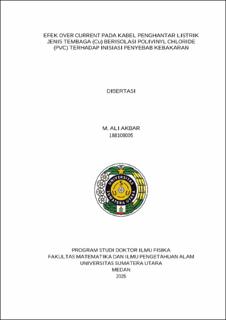Efek Over Current Pada Kabel Penghantar Listrik Jenis Tembaga (Cu) Berisolasi Polivinyl Chloride (PVC) terhadap Inisiasi Penyebab Kebakaran
Effects of Over Current On Copper (Cu) Insulated Polyvinyl Chloride (PVC) Electrical Conducting Cables on the Initiation of Fire

Date
2025Author
Akbar, M. Ali
Advisor(s)
Tarigan, Kerista
Humaidi, Syahrul
Ramdan, Dadan
Metadata
Show full item recordAbstract
This study aims to analyze the physical and chemical effects of electromigration failure caused by overcurrent in copper (Cu) cables as a potential initiator of electrical fires. Testing was conducted on PVC-insulated copper cables with varying current levels: 0 A, 21 A, 50 A, 70 A, 100 A, and 110 A under a constant voltage of 220 V. Experimental results indicate that samples with no current (0 A) and those exposed to 21 A showed no changes in macro or microstructures. However, samples subjected to currents of 50 A and above exhibited significant physical changes, including the formation of hillocks and voids on the cable surface, starting 253°C, progressing to 800°C, and breaking at 1091°C. Additionally, increased current flow caused the phenomenon of electromigration, characterized by the movement of copper atoms due to high current density, leading to voids and hillock formation. Growing voids can sever circuit connections (open circuit), while expanding hillocks can bridge circuit connections (short circuit), resulting in total cable deformation. These findings highlight the potential risks of cable failure as a cause of electrical fires.
